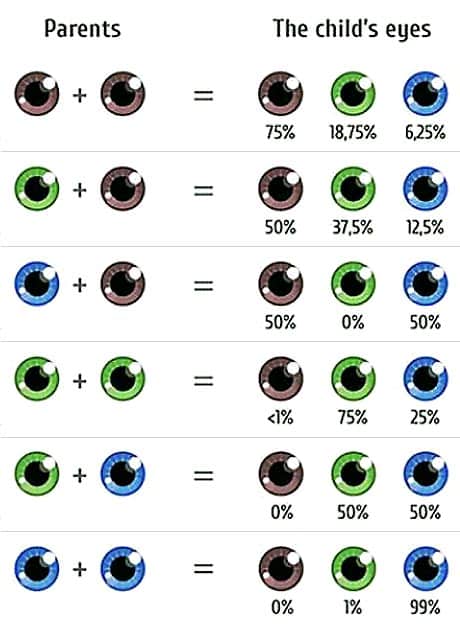Uncovering The Genomic Secrets Of Color Variants In Female Cuckoo Birds
Table Of Content

In addition to altering color in natural hair, sun exposure can damage the DNA and proteins that create melanin, leading to abnormal pigment formation or reduced production. Different combinations and expressions of hair color genes can produce various shades and tones. For example, one gene might control the amount of eumelanin, while another might affect pheomelanin.
Scientists Sequence Genome, Reconstruct Face of Chinese Emperor Wu
If someone inherits one dominant and one recessive allele, they may exhibit the dominant trait—but this isn’t always guaranteed. The presence of dominant and recessive traits further adds to the complexity. But which color variant has the greatest advantage for these birds?
Baby PTC Taste Predictor

Treating hormonal imbalances can help restore the original hair color, but consulting a healthcare provider is crucial for the right course of action. These characteristics, or traits, are decided by genes, part of the DNA, acting like a recipe book for the body. Inside every cell, there are chromosomes carrying these genes, working together to control our appearance and function.
Scientists Decode Etruscan Shrew Genome
Your hair may change color at different points in your life naturally, without the help of a bottle of dye. Some hair types can get lighter when exposed to lots of sunshine, though the difference is more noticeable in lighter shades. Changing hormone levels at puberty also affect melanin production, causing some children’s hair to turn from lighter to darker as they approach adulthood. In older age, hair often stops producing melanin and loses its color. Hair color is just one feature that comes from the combined efforts of all of a person’s genes plus their environment. We can identify some big-picture patterns like the dominance of brown hair over blond, but we need more detailed models to explain colors like strawberry blond or how color changes with age.

Genotypes for more than 800,000 SNPs and indels were directly assayed by UK Biobank using custom Affymetrix arrays, and an additional ~40 M variants imputed using the Haplotype Reference Consortium panel16. On the other hand, recessive traits require both copies to be present for their trait to be visible. “Then the advantage of the rufous morph comes into play, as it is less common and has not been learned by the hosts,” Professor Wolf stated. There are a lot of myths and misinformation about the genetic causes of male pattern baldness (MPB). One of the most enduring is that you inherit it from your mother. Male pattern baldness can start as early as the late teens and early 20s, and usually works backward from the temples to eventually cause partial or total baldness on the top and sides of your scalp.
Girl Can Switch Hair Color Between Blond and Brunette Due to Rare Genetics - Newsweek
Girl Can Switch Hair Color Between Blond and Brunette Due to Rare Genetics.
Posted: Wed, 02 Feb 2022 08:00:00 GMT [source]
Brown-haired girls or women of European, West Asian or North African descent are often known as brunettes. In general, darker hair colors, such as black and brown, are dominant. This means that these hair colors are more likely to appear in individuals if one of the parents has dark hair.
So how can you know which one of your parents gave you which gene? Well, we’ll talk about that in a minute, but first, let’s take a look at the different “hair genes” and what they really mean to you. If both parents are blonde, it is possible to have a blonde child due to a recessive mode of inheritance where both parents pass on the blonde gene.
Gray hair is partly hereditary and may vary by ethnic origin; it is also somewhat dependent on external factors such as stress. Hair becomes gray when the hair follicle loses its ability to make melanin, but exactly why that occurs is not clear. The type and amount of melanin in hair is determined by many genes, although little is known about most of them. This gene provides instructions for making a protein called the melanocortin 1 receptor, which is involved in the pathway that produces melanin.
This can contribute to the diverse range of colors observed across generations. If someone inherits alleles that produce both in equal amounts, they are more likely to have red hair. The Tech Interactive at Stanford University provides a Q&A page about hair color.
Numerous online tools and calculators boast the ability to foresee a baby’s hair color. However, their accuracy is often limited by the complexity of genetics. For example, environmental influences and medical conditions can significantly shape our hair colors and appearance. Conversely, if someone inherits alleles that lead to higher levels of pheomelanin production, they are more likely to have light hair. Your hair color is determined by the amount of melanin in your hair. Your genes influence this amount and the type of melanin in your hair.
Stress can trigger the release of cortisol, a hormone that can suppress the activity of melanocytes and reduce melanin production. PICS calculates the conditional posterior probability P(Bcausal|Alead), that is the probability that SNP B is the causal variant given SNP A is the lead SNP. Hair color inheritance involves a blend of various genes, alleles, and inheritance patterns that can result in unexpected outcomes.
In other words, forensic scientists might one day be able to tell someone’s natural hair color based on DNA alone. Scientists have identified a group of 124 genes that direct human hair pigmentation. While previous studies have shown that this feature is genetically controlled, it’s the first time the specific genes have been pinpointed. This could not only allow us to better understand our own genome but it could also shed new light on skin, testicular, and ovarian cancer, as well as several other diseases. Variants of the gene MC1R that lead to a loss of function of the protein can affect the production of pheomelanin. In contrast, there are many genes across our genome that involved eumelanin variation, including less damaging genetic variants in the same MC1R gene.
Comments
Post a Comment